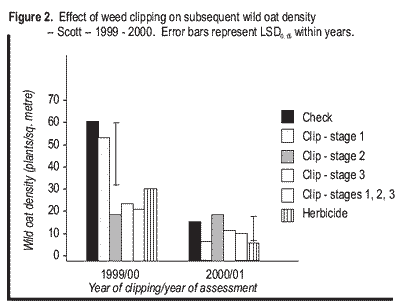Clipping weeds above a crop canopy
E. Johnson - Scott Research Farm
Problem
Weed control is a challenge for organic growers. Organic producers rely on crop rotation, cultural practices, and mechanical means to control weeds. Weeds in short stature crops such as flax and lentil can be particularly problematic. This study’s objectives were: 1) to develop or modify field equipment that could clip weeds above the crop canopy, 2) to determine if weed clipping improves crop yield, and 3) to determine if weed clipping influences weed seedling densities in the subsequent growing season.
Background
Some organic producers have experimented with clipping weeds above the canopy of short stature crops such as lentil or flax. While clipping weeds may provide some aesthetic value, it is not known whether the practice will affect crop yield or weed seed return to the soil seed bank. A project was initiated in 1999 to develop or modify equipment for weed clipping and to evaluate whether the practice improved crop yield and/or reduced weed seedling recruitment the following growing season. At Scott, a field experiment was conducted over two years where clipping at various stages of weed development was evaluated. Clipping was done above a lentil crop canopy with a gas-powered hedge trimmer. The Prairie Agriculture Machinery Institute (PAMI) at Humboldt modified the cutting component of a self-propelled swather and carried out field trials on four farm fields.
Study description
Scott experiment
- Conducted in 1999 and 2000
- Experimental design: RCBD
- CDC Glamis lentils seeded on May 18, 1999 and May 8, 2000
- Lentil seeded in 22 cm rows at a rate of 130 kg/ha
- Wild oat and wild mustard seeded at a density of 100 seeds/m between the crop rows
- Clipping done at these timings:
1. Wild mustard in full flower/ Wild oat in boot stage;
2. Wild mustard podded/ Wild oat headed;
3. Wild mustard seed wateryripe/ Wild oat mid-dough stage; - Herbicide and unclipped weedy checks were included.
- Herbicide treatment: postemergence sequential application of metribuzin (212 g ai/ha ) sethoxydim ( 212 g ai/ha ).
Data collection included crop yield and wild mustard and wild oat seedling emergence the following spring (plants m ) prior to seeding. In the spring of 2001, lambs quarters ( Chenopodium album L) emergence was also recorded.
PAMI field trials Fields were clipped above a lentil or flax crop with a modified swather. Each field also had an unclipped check strip.
Major findings
Weed clipping did not result in a detectable lentil yield increase in either year (Figure 1). Clipping must be postponed until the weeds elongate above the crop canopy. Most of the yield loss associated with weed competition occurs in early crop development stages.Although variable, clipping reduced subsequent weed seedling emergence. Clipping in 1999 reduced wild oat emergence the following spring if the clipping occurred after wild oat heading (Figure 2). In the 2000 - 2001 study, wild oat populations were low and clipping did not cause a significant reduction in emergence. There was no detectable difference in wild mustard recruitment in the 1999 - 2000 study, but there was a trend towards lower densities when the wild mustard was clipped at the podding stage (Figure 3). Many of the pods formed below the crop canopy in the first year of the study, which reduced the efficacy of clipping. Clipping at anyy weed stage was effective in reducing wild mustardd recruitment in the 2000 - 2001 study (Figure 3). Recruitment of lambs quarters showed similar results (Figure 4).Field studies conducted by PAMI showed similar trends to the Scott trials (Table 1).
Table 1. Effect of weed clipping on subsequent wild oats and wild mustard density (plants/m2). Mean of four field trials conducted by PAMI. Fields used as replicates to determine LSD. Assessments done in spring of 2001.
| Ìý | Wild oat density (plants/m2) |
Wild mustard density (plants/m2) |
|---|---|---|
| Unclipped | 29 | 17 |
| Clipped | 6 | 6 |
| LSD0.05 | 22 | 21 |




Conclusions
While results are preliminary, weed clipping may have potential as a means of reducing weed seed return following a short stature noncompetitive crop. Further study is warranted to define optimum timing for clipping and to improve consistency of results.
Acknowledgements
Funding provided by the Canada-Saskatchewan Agri-Food Innovation Fund
Originally published in Research Report 2002, Canada-Saskatchewan Agri-Food Innovation Fund
